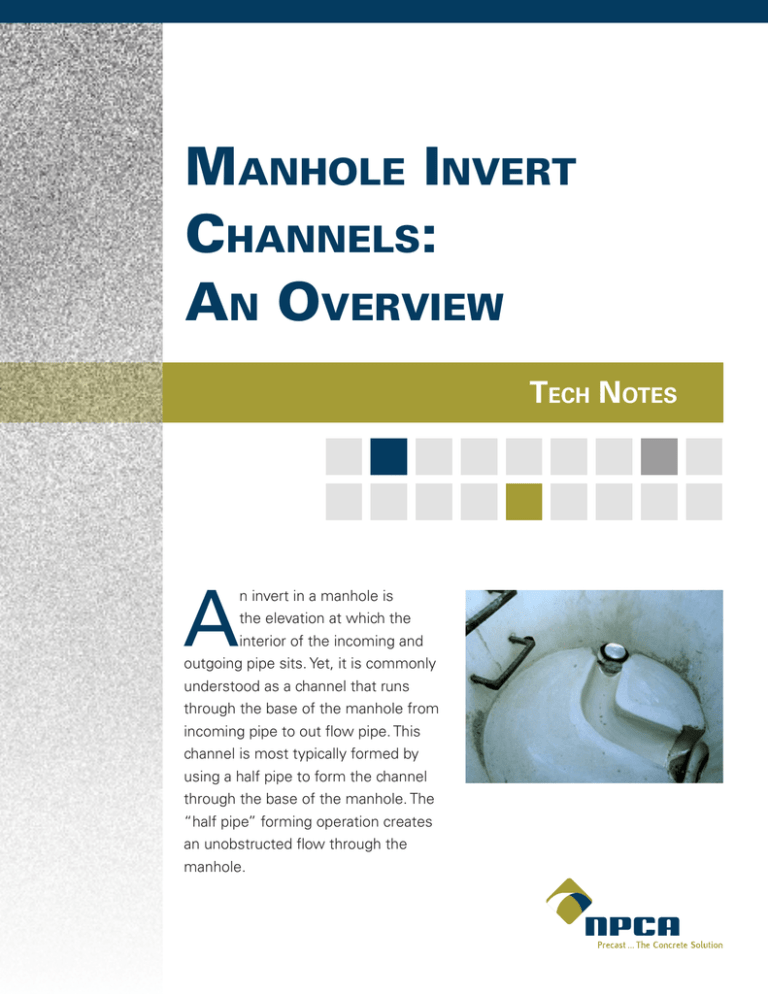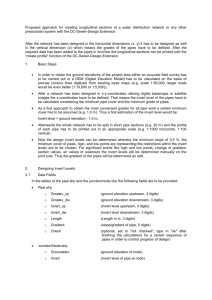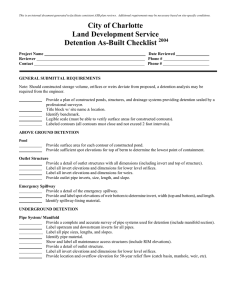manhole invert channels: an overview
advertisement

Manhole Invert Channels: An Overview Tech Notes A n invert in a manhole is the elevation at which the interior of the incoming and outgoing pipe sits. Yet, it is commonly understood as a channel that runs through the base of the manhole from incoming pipe to out flow pipe. This channel is most typically formed by using a half pipe to form the channel through the base of the manhole. The “half pipe” forming operation creates an unobstructed flow through the manhole. Invert Design Generally, invert channels will conform to following criteria (see Figure 1): • Slope of invert bench: 0.5 inch per foot minimum; 1.5 inch per foot maximum; • Depth of bench to invert: minimum one-half of largest pipe diameter; • Invert slope through manhole: 1.2 inch drop across manhole with smooth transition of invert through manhole, unless otherwise indicated on construction drawings. Benching Manhole benching affects the hydraulic flow through the manhole unit during drainage events and sanitary sewer flows. The two most common benching configurations are a half bench and a full bench. In the case of a half bench, the lower half of the pipe shape extends through the manhole while the horizontal benches are extended from the semi-circular channel to the manhole interior wall. A full bench is formed with a full-depth channel, providing improved FIGURE 1: A typical manhole section. hydraulics. FIGURE 2: Invert channel with half bench. 2 Tech Notes - Manhole Invert Channels: An Overview | FIGURE 3: Invert channel with full bench. precast.org Typical bench layout before installation. The Importance of Quality Invert Benching Scour is defined as degradation of a material due to the invert channels and benching are formed with hydrodynamic forces. It is a specific form of erosion. continuous smooth surfaces, manufactured with While concrete is very resistant to scour, stormwater high quality concrete and then properly aligned when can carry substantial amounts of solids into a storm installed. system and the invert channels may experience Inverts are typically formed with a pocket for the pipe scouring from a process known as “shock loading.” to enter the manhole and butt up against the flow Invert channels that are poorly formed or misaligned channel of the invert (see Figures 2 and 3). with the inlet and outlet pipe may tend to trap abrasive solids during a minor drainage event. Severe drainage events will tend to quickly flush these abrasive particles at high velocities resulting in scour abrasion of the invert and bench levels. It is important that A non-skid finish on the benching may be required to accommodate maintenance and cleaning personnel. This can be accomplished by using a broom finish or applying a non-skid material post-pour. Installation There are several methods used by precasters or The minimum concrete thickness from the contractors to create invert channels in precast invert to the bottom of the base slab should be 4 concrete manholes. They include installation at the inches, according to ASTM C478 Section 15.3.2.1. plant and field installation. • In a secondary pour, the invert channel is installed in a manhole base. The manhole base and walls Installation at the will be cast first. When cast monolithically this Precast Plant • In a primary pour, the channel, base and walls of is often referred to as a mono-base. The hole the manhole are formed monolithically as one penetrations for the incoming and outgoing pipes casting. This is typically done upside down and can be formed in the mono-base or they may then flipped to remove the product from the be cored after the mono-base has cured. The form, thereby leaving the appropriate channeling. next step is to form the invert channel with form systems that may be fixed or modular. Once the 3 Tech Notes - Manhole Invert Channels: An Overview | precast.org forming channels have been properly installed and an anti-floatation bar has been secured, the concrete is poured around the suspended channel. These inverts may also be hand-formed. The minimum concrete thickness under the invert channel should be 2 inches, according to ASTM C478 Section 15.3.3.3. Field-Poured Manhole Benching In order to ensure the best quality product, inverts should be manufactured in the precast plant along with the manhole section, cured, and then delivered to the site. However, there are specific instances where pouring of inverts must be done in the field. The following precautions should be followed: • For precast manhole bases, the area underneath the manhole base must be excavated to the required elevation. The soil below the base should Monolithic invert mounted on dome. not be disturbed, or if fill is required it should be properly compacted. The manhole base is then as the foundation of the invert and then add a lowered into the trench and checked for proper thin coat of concrete on the surface. This method bearing on the sub-grade, proper elevation and should not be used because it does not produce orientation to receive the incoming and outgoing a durable invert, which could lead to future sewers at the designated invert elevation. The maintenance problems. base should be set to the invert elevations • As with invert channels manufactured at the specified on the plans. If the base is not set plant, field-poured channels and benching must within plan specifications, it may have to be be constructed only with high-quality concrete. removed and reset. The channels should then be consolidated, finished, cured and properly placed. The minimum • The concrete invert will be poured after connecting the sewer pipes to the manhole. concrete thickness must be 2 inches, according The invert must be true to the sewer pipe invert to ASTM C478. elevations, with smooth channels of uniform • To eliminate free-fall conditions in a manhole cross section and slope, either straight or with resulting from invert elevation differentials a continuous curve between the inlet and outlet between incoming and outgoing pipes, the of the pipes. The concrete invert should be contractor should form and construct suitable placed based on the dimensions and details channels in the bottom of the manhole of the contract plans and specifications. Some connecting the inverts. installers use dirt, brick and other loose material 4 Tech Notes - Manhole Invert Channels: An Overview | precast.org Channelization Plan of Mainline Sewer Manholes Channel Lining Notes • Channel lining must be constructed of properly designed and placed concrete. • Width of channel should match the inside diameter of incoming and outgoing pipes • Channel lining should be blended for smooth contour between pipes • All invert elevations should be shown on the drawings. This publication is designed to provide accurate and authoritative information, however the National Precast Concrete Association does not guarantee the validity or accuracy of any data, claim or opinion appearing in this publication. If engineering, legal or other professional services are required, the services of a competent professional should be obtained. The National Precast Concrete Association does not assume and hereby disclaims liability to any person for any loss or damage caused by errors or omissions in this publication, regardless of whether such errors result from negligence, accident or any other cause whatsoever. 5 Tech Notes - Manhole Invert Channels: An Overview | precast.org March 2013




